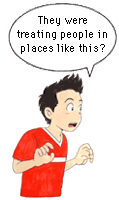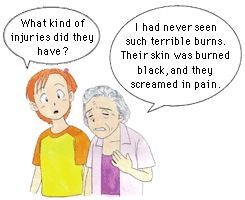
| Relief Activities amid the Turmoil |
|
Hiroshima's air defense and relief systems, prepared in case of air raids,
were destroyed instantly by the atomic bomb. Buildings collapsed under the blast and rubble filled the streets. The enormous fire that followed burned the entire city. City and prefectural government functions were lost. Communication and transportation were paralyzed. The city fell into chaos. Despite the turmoil, rescue and relief efforts began immediately. These activities were implemented primarily by the Army Marine Headquarters (commonly known as the Akatsuki Corps), other military personnel, and the doctors, nurses and policemen who managed to survive. Rescue and relief began the very day of the bombing, faced with overwhelming waves of injured humanity. |
 |
 |
| 16 Relief activities of the Akatsuki Corps 1August 6, 1945 / Sakai-machi (1,050m from the hypocenter) The first to come to the rescue was the Army Marine Headquarters (known as the Akatsuki Corps), which was stationed four kilometers from the hypocenter and received only slight damage. Blocked from the city by the fire engulfing it, they came up the rivers in boats to fight it and rescue the injured. |
17 Taking in the injured August 6, 1945 / Army Transport Quarantine Station on Ninoshima Island (9,000m from the hypocenter) The Akatsuki Corps ferried thousands of injured victims by boat from Ujina Port to the military quarantine station on Ninoshima Island in Hiroshima Bay. Soon, the large quarantine station buildings and even the yards outside were full of victims. By that evening, over 1,000 people had been sent on from Ninoshima to Saka Village, Aki County (now, Saka-cho, Aki-gun). |
 |
 |
| 18 Policemen giving first aid to the injured August 6, 1945 / Miyuki Bridge (2,270m from the hypocenter) Those exposed to the bomb outside near the center of the city toward the hypocenter were struck by heat rays hot enough to burn off their clothes. Their skin was so burned that it peeled and dangled in shreds. Those able to escape the fires tended to gather at the ends of bridges or down by the rivers. Doctors and policemen, many ignoring serious injuries of their own, hurried to offer first aid to others. |
19 Emergency bag and medical supplies |
 |
 21 Disaster certificates |
 22 Disaster certificates |
| 20 Issuing disaster certificates August 6, 1945 / Minami-machi 3-chome (2,500m from the hypocenter) Disaster certificates were issued to survivors immediately after the bombing, making them eligible to receive emergency food and to use public transport without charge. Police and other officials in Hiroshima City began writing certificates the day of the bombing. |
||
 |
 |
| 23 Crowds of injured pushing in August 6, 1945 / Hiroshima Red Cross Hospital Senda-machi 1-chome (1,500m from the hypocenter) The Hiroshima Red Cross Hospital and the Communications Hospital were badly damaged but remained intact. Immediately after the bombing, crowds of injured appeared at these hospitals seeking help. Though most were injured themselves, doctors and nurses worked desperately to provide treatment, even on the day of the bombing. |
24 Lines of injured fleeing the city August 6, 1945 / Kabe Line tracks Victims fleeing the fire and seeking help tended to head from the city to the outskirts. The roads leading out were filled with long lines of injured people. In surrounding towns and villages, volunteers pitched in to receive them and nurse them. |
| 25 A medical relief team preparing to go to Hiroshima August, 1945 / Hiroshima Sanatorium for Disabled Veterans Saijo-cho, Kamo-gun (now, Higashi-hiroshima City) As the victims streamed toward the outskirts, others headed into the destroyed city to help with rescue and relief. In surrounding towns and villages, it had been decided in advance that if Hiroshima were bombed, relief teams would form and go into the city to help out. As planned, medical relief teams from various communities boarded trucks and trains and headed for Hiroshima. Team members were told that a "new type of bomb" had been used, but no one had ever heard of an atomic bomb. |
 |
 |
26 Establishment of emergency relief stations August 6, 1945 / Hijiyama Hill (1,750m from the hypocenter) Nearly all the relief stations that had been set up for air raids were destroyed by the atomic bomb. Treatment was provided wherever victims gathered, and many such places were turned into emergency relief stations. However, these makeshift stations lacked adequate medicines and personnel. Cries of agony filled the air. |


 |
 |
| 27 Armband  |
|
| 28 First-aid Kit for Imperial Army |
29 Distributing rice balls to the injured August 6, 1945 / Senda-machi (2,000m from the hypocenter) Food was delivered as quickly as possible to the bomb victims. Emergency rice balls and hardtack were distributed, but many of the injured lacked the strength to eat. |
| 30 The new Air Defense Headquarters End of September, 1945 / Tamonin Temple Dambara-cho (now, Hijiyma-cho) (1,750m from the hypocenter) The Hiroshima Prefecture Air Defense Headquarters was responsible for directing relief activities, but the prefectural office buildings were completely burned and destroyed. All air defense functions were paralyzed. It was 5 p.m., nine hours after the bombing, when a new prefectural air defense headquarters was established at Tamonin Temple on Hijiyama Hill, which was the designated emergency refuge for the prefectural government. The mountain gate had collapsed and the main hall was largely destroyed, but when the governor returned from an official trip on the day of the bombing, he and his surviving staff and police assembled here to dispatch medical relief teams and request support. |
| Helping
Victims in the Burnt Plain -- Relief Activities with neither Medicine nor Food to Offer -- Preparing for Air Raids Relief Activities amid the Turmoil Full-scale Relief Activities Conditions in Relief Stations and the Suffering of the People(1) Conditions in Relief Stations and the Suffering of the People(2) Relief Activities by the Akatsuki Corps on August 6 Conclusion Individuals and Group Contributors to This Exhibition Return to TOP |